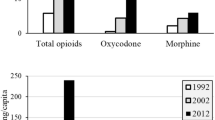Abstract
Five metabolites of diclofenac sodium (Voltarol®) have been identified in human plasma. All five metabolites were more than 50 times less potent than diclofenac in inhibiting PGE2 production in zymosan-stimulated mouse macrophages and LTC4 synthesis was not inhibited in these cells. Anti-inflammatory activity (adjuvant arthritis and carragheenan-induced paw oedema in rats) and analgesic activity (phenyl-p-benzoquinone writhing, mouse) of the metabolites were at least 10 times lower when compared to diclofenac. There was a good correlation betweenin vitro PGE2 inhibition andin vivo activities for diclofenac and its metabolites indicating that inhibition of prostaglandin synthesis is a major mechanism responsible for their pharmacological actions.
Similar content being viewed by others
References
A. P. Todd and E. M. Sorkin,Diclofenac sodium. A reappraisal of its pharmacodynamic and pharmacokinetic properties, and therapeutic efficacy. Drugs35, 244–285 (1988).
H. Stierlin, J. W. Faigle, A. Sallmann, W. Kueng, J. W. Richter, H.-P. Kriemler, K. O. Alt and T. Winkler,Biotransformation of diclofenac sodium (Voltaren ®)in animals and in man. I. Isolation and identification of principal metabolites. Xenobiotica9, 601–610 (1979).
H. Stierlin and J. W. Faigle,Biotransformation of diclofenac sodium (Voltaren ®)in animals and man. II. Quantitative determination of the unchanged drug and principal phenolic metabolites, in urine and bile. Xenobiotica9, 611–621 (1979).
P. H. Degen, W. Dieterle, W. Schneider, W. Theobald and U. Sinterhauf,Pharmacokinetics of diclofenac and five metabolites after single doses in healthy volunteers and after repeated doses in patients. Xenobiotica18, 1449–1455 (1988).
J. W. Faigle, I. Boettcher, J. Godbillon, H. P. Kriemler, E. Schlumpf, W. Schneider, A. Schweizer, H. Stierlin and T. Winkler,A new metabolite of diclofenac sodium in human plasma, Xenobiotica18, 1191–1197 (1988).
R. Menasse, P. R. Hedwall, J. Kraetz, C. Pericin, L. Riesterer, A. Sallmann, R. Ziel and R. Jaques,Pharmacological properties of diclofenac sodium and its metabolites. Scand. J. Rheumatol.22, 5–16 (1978).
I. Wiesenberg-Boettcher, A. Schweizer, J. R. Green, K. Mueller, F. Maerki and J. Pfeilschifter,The pharmacological profile of CGP 28238, a novel highly potent anti-inflammatory compound. Drugs Expl. Clin. Res.XV, 501–509 (1989).
A. Schweizer, R. Brom and H. Scherrer,Combined automated writhing/motility test for testing analgesics. Agents and Actions23, 29–31 (1988).
Author information
Authors and Affiliations
Rights and permissions
About this article
Cite this article
Wiesenberg-Boettcher, I., Pfeilschifter, J., Schweizer, A. et al. Pharmacological properties of five diclofenac metabolites identified in human plasma. Agents and Actions 34, 135–137 (1991). https://doi.org/10.1007/BF01993259
Issue Date:
DOI: https://doi.org/10.1007/BF01993259




